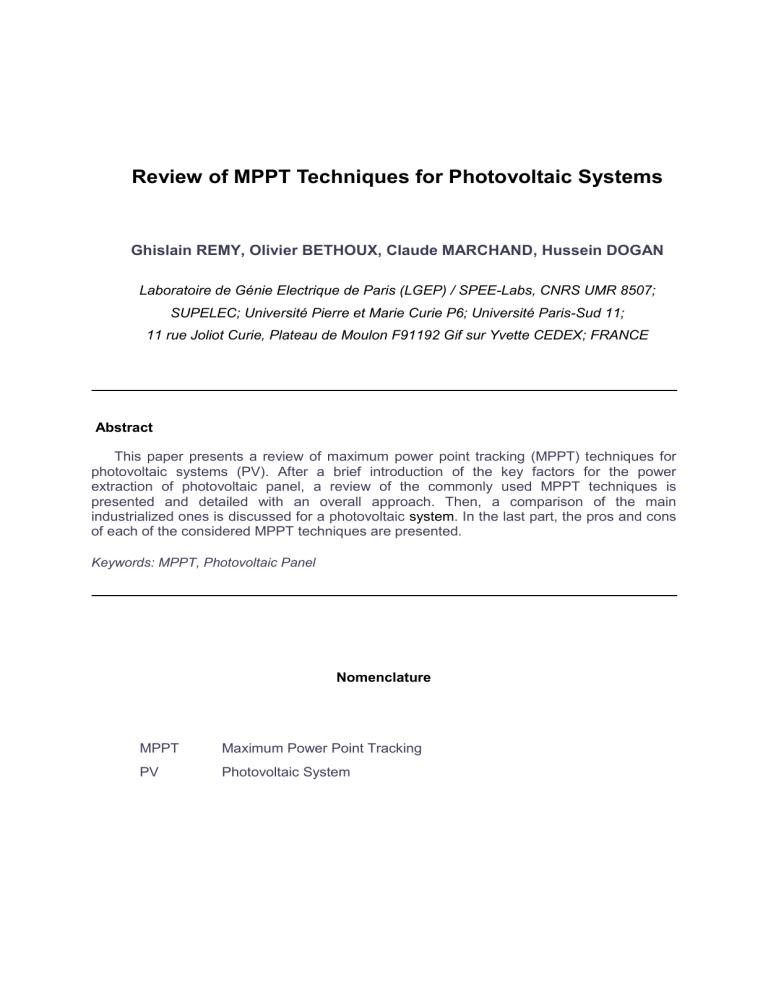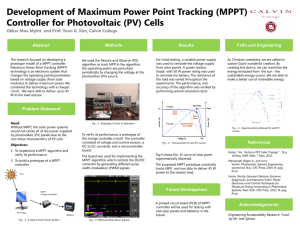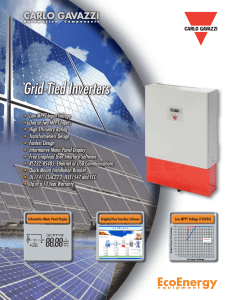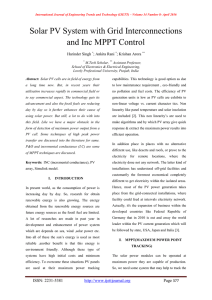Review of MPPT Techniques for Photovoltaic Systems

Review of MPPT Techniques for Photovoltaic Systems
Ghislain REMY, Olivier BETHOUX, Claude MARCHAND, Hussein DOGAN
Laboratoire de Génie Electrique de Paris (LGEP) / SPEE-Labs, CNRS UMR 8507;
SUPELEC; Université Pierre et Marie Curie P6; Université Paris-Sud 11;
11 rue Joliot Curie, Plateau de Moulon F91192 Gif sur Yvette CEDEX; FRANCE
Abstract
This paper presents a review of maximum power point tracking (MPPT) techniques for photovoltaic systems (PV). After a brief introduction of the key factors for the power extraction of photovoltaic panel, a review of the commonly used MPPT techniques is presented and detailed with an overall approach. Then, a comparison of the main industrialized ones is discussed for a photovoltaic system . In the last part, the pros and cons of each of the considered MPPT techniques are presented.
Keywords: MPPT, Photovoltaic Panel
Nomenclature
MPPT
PV
Maximum Power Point Tracking
Photovoltaic System
1. Introduction
The reduction of the fossil energies and uranium reserves make renewable energies more and more important (Hydro-electricity, Wind turbines, Solar panels …). Furthermore, these energies offer a good opportunity to reduce the global-warming effect. Among them, the photovoltaic systems ’ manufacturing process has been improving continuously over the last decade and photovoltaic systems have become an interesting solution. Precisely, photovoltaic systems are constituted from arrays of photovoltaic cells, choppers (mainly buck-boost or boost DC/DC converter), MPPT control systems and storage devices and/or grid connections. To improve the efficiency of such systems, various been performed [1]-[4].
But, as solar energy is diffuse (less than 1 kW/m
2
), and photovoltaic cell efficiency is theoretically limited to 44%, efforts need to be strengthened on the energy transfer. This includes the design of the photovoltaic system and the energy management by seeking the
Maximum Power Point (MPP). Large amount of publications can be found on MPPT [1]-[38], and it is not easy to apprehend their differences and to estimate their performances.
The main contribution of this paper is to propose a comparison of MPPT techniques:
Firstly, the photovoltaic theory will be introduced and the main parameters of the photovoltaic systems will be emphasized in order to focus on the MPPT key factors. Then, some of the most used MPPT techniques are explained and pros and cons are given . However, the last improvement of actual research on MPPT is not taken into account. Some criteria, such as efficiency, tracking time, stability, robustness, and cost, will be introduced in order to compare the chosen MPPT methods. Finally, comparisons of the simulations will be performed using Matlab/Simulink® software.
1.1. Main Photovoltaic Technologies
The principle of Photovoltaic System is simple: it is a direct conversion of light to electricity. Since the 1950's, and the first crystalline silicon PV from the Bell Labs [8], many material have been put into solar cells [9]: crystalline silicon, amorphous silicon, III-V's and concentrated, CuInGaSe2 (CIGS), CdTe, organic, dye-sensitized, etc.
The main industrialized
PV technologies are shown in Fig.1:
Fig.1. Themain industrialized PV technologies a) mono-crystalline PV b) poly-crystalline PV c) amorphous PV
This large variety of PV technologies provides great opportunities but also great obstacles for PV manufacturing. Indeed, by continuously inventing new processes and materials, it creates an industry that has no material handling standards. Furthermore, each material has a different light absorption capability, especially regarding the incident light spectrum. It means DC Choppers and MPPT techniques have to be customized for each application. So it greatly reduces the standardization possibilities and so the desirable cost reduction of massive productions.
To improve the energy management of photovoltaic systems, it’s important to model and to analyses its intrinsic characteristics.
1.2. Model of Photovoltaic Cells
The principle of the photovoltaic effect is simple: The ray of light, assimilated to photons, passes through the top layer (N doped) of the photovoltaic cell. Then, electrons capture the photons’ energy and help them to cross the potential barrier of the PN junction, which generates current. So there is a strong relation between the solar irradiance and the amplitude of the generated current, as in (1).
As the solar cells characteristic is close to a semiconductor diode, a classical model can be found in literature [5]:
Fig.2. Equivalent model of a photovoltaic cell
The cell current can be expressed as:
I
I ph
d
I r
, with I ph
I cc
i
T
T
STC
E
Er
I d
I
S
exp
d
1 , and I
Sinit
I
SC
/ exp
OC
init
1
I
S
I
Sinit
T
T init
3
exp
g
1
T
T
1 init
, and V
OC
V
OCinit
T
T init
)
Finally, the following equation then describes the entire PV panel [5]:
I
PV
n p
I ph
n p
I rs
exp
q
V
PV k T A n s
1
(1)
(2)
(3)
(4)
Where,
I: Output current of the cells (in A)
T: Temperature of the cells(in °K)
E: Solar irradiance (in W/m²)
Er: Solar irradiance reference (here:1000 W/m²)
Iph: Current induced by E and T (in A)
Is: Saturation current (in A)
Id: Diode current (in A)
Vd: Diode voltage (in V)
Rs: Equivalent series resistance of the resistive contacts(here: 0.5 Ohms)
Rsh: Shunt resistance representing the leaking currents (here: 500 Ohms)
q: Electron charge (1.602*10^-19 C)
k, Boltzmann constant (1.38*10^-23 J / K)
Tinit, Initial temperature of the PV Cell (here: 298 K)
Isc, Short-circuit current (here: 3.33 A)
Vocinit, Initial open-circuit voltage (here: 21.3 V)
ki :Temperature versus current coefficient (here: 0.0025A/°C)
ns: number of PV cell in series (here: 36)
np: number of PV cell in parallel (here: 1)
This model is based on classical assumptions:
All the photovoltaic cells have the same v(i) characteristics;
There is no partial shadow on the PV panels;
Temperature is homogeneous on panels.
Hence, performances of PV technologies are really dependent on the sunshine, the cloudiness, the solar incidence and the temperature.
1.3. Analyze of the PV Characteristics
Figure 3 shows the voltage versus current PV characteristics of the selected PV Panel of about 50W with some solar irradiance variations.
Fig.3. Solar irradiance influence on PV characteristic, at 25°C
Current versus Voltage and Power versus Voltage of the PV characteristics
Figure 4 shows the voltage versus current PV characteristics of the selected PV Panel of about 50W, with some temperature variations:
Fig.4. Temperature influence on PV characteristic, at 1000 W/m²
Current versus Voltage and Power versus Voltage of the PV characteristics
To improve the efficiency of PV systems, MPPT must take into account:
Main parameters, which are the solar irradiance and the temperature.
Less important parameters, which are the light incidence, the cells ’ aging, and the irradiance spectrum. But, they are neglected in most MPPT techniques.
Datasheet of PV systems have a characteristic dispersion of about 10% due to complex manufacturing processes.
An increase of the PV temperature induces a fast diminution of the PV Voltage.
Furthermore, as the maximum output voltage value is very low, about 20 volts only, an adaptation of the PV voltage becomes necessary.
1.4. Boost converter, DC-DC Chopper
As photovoltaic cells are only able to produce more than 2V a cell, series and parallels are used in PV Array. But in order to reduce the losses in the energy transfer, it is better to boost the PV voltage using a DC-DC converter [10], [11]. Figure 5 shows a schematic of a classical Boost Converter, using the SimPowerSystems® Toolbox from the Matlab software:
Fig.5. Scheme of a Boost Converter for PC Systems
The boost converter used the simulations is composed of the following values: 1mF capacity Ce, 1mH inductance L, 1 μF capacity C, and 50Ώ resistances R and R1.
This DC chopper is controlled using a Pulse-Width Method (PWM) and the duty cycle d is calculated for tracking the Maximum Power Point of the PV systems.
2. Review of MPPT Techniques
There are many MPPT methods available in the literature [1]-[30]; the most widely-used techniques are described in the following sections:
Constant Voltage (CV) Method [12], [13]
Open Voltage (OV) Method [12]
Temperature Methods [16]
Incremental Conductance (IC) Methods [14], [15]
Perturb and Observe (P&Oa and P&Ob) Methods [17]-[27]
Three Point Weight Comparison [28]
Short-Current Pulse Method[31], [32]
Fuzzy Logic Method [29], [30]
Sliding Mode Method[33], [34]
Artificial neural networkMethod[35], [36]
2.1.Constant Voltage (CV) Method
The principle of the Constant Voltage (CV) Method is simple: the PV is supplied using a constant voltage. Temperature and Solar Irradiance impacts are neglected. The reference voltage is obtained from the MPP of the P(i) characteristic directly. Here, the MPP voltage is about 16.3V for the studied PV. Figure 6 shows the CV algorithm and the code of the Matlab embedded function: d= d –K
Init
V and Vref
Measures
Yes
V == Vref
Yes
No
No
Vref > V d= d+K function y=CV(u)
global Kcv d_cv
Kcv=0.01;
% u(1) is the constant PV voltage reference
% u(2) is the measure PV voltage
If (u(1)==u(2))
C = d_cv;
else if (u(1)>u(2))
C = d_cv –Kcv;
else
C = d_cv +Kcv;
end end d_cv = C; y = d_cv;
Fig.6. CV algorithm and the code of Matlab embedded function
The CV method requires the PV voltage measurement only. The Matlab embedded function is evaluated with a 1 kHz frequency. This Constant Voltage Method cannot be very effective regarding Solar Irradiance impact and certainly not regarding the temperature ’s influence. Thus, some enhancements of the CV methods exist:
- The Open Voltage (OV) Method is based on the CV method, but it makes the assumption that the MPP voltage is always around 75% of the open-circuit voltage v
OC
. So mainly, this technique takes into account the temperature (as can be seen in Fig. 6). But it requests a special procedure to regularly disconnect the PV and to measure the open-circuit voltage. Besides, this technique can partially take into account the cell ’s aging.
- The Temperatures Method is also an improvement of the OV Method: the open-circuit voltage is now considered to be related to the temperature by a linear function. Then, with a temperature sensor, the open-voltage measurement is no more necessary, because its value can be identified from the temperature value directly [16].
2.2.Incremental Conductance (IC) Methods
The principle of the Incremental Conductance (IC) Method is based on the property of the
MPP: the derivative of the power is null, as in (5). So, the IC method uses an iterative algorithm based on the evolution of the derivative of conductance G, as in (6). Where the conductance is the I/V ratio. dP
0, dV with P V I (5) dP dV
V dI
dV
I dV dV
0, Thus : dI
I
0
dG G 0 dV V
(6)
This method (ICa) has been improved, because when the voltage is constant, dG is not defined. So, a solution is to mix the CV method with the IC method. It is known as the Two-
Method MPPT Control (or ICb). Figure 7 shows the Two-Method MPPT Control algorithm and the code of the Matlab embedded function: dG > –G
No
No dG == –G
No
Yes
Yes
Init
I k and V k
Measures
V k
== V k-1
Yes
Yes
Save i k
, V k and d
Yes i k
== i k-1 i k
> i k-1
No
No function y=IC(u) global i v Kic d_ic
Kic=0.01;
% u(1) is the measure PV current
% u(2) is the measure PV voltage
G=u(1) / u(2); %G is the conductance dv = u(2) – v; di = u(1) – i; if (dv==0) %equivalent to the CV method if (di==0) C = d_ic; else if (di > 0) C = d_ic + Kic; else C = d_ic – Kic; end
end else dG = di / dv; % here start the IC method if (dG== –G) C = d_ic; else if (dG > –G) C = d_ic – Kic; else C = d_ic + Kic;
end
end end i= u(1); %save old current value v=u(2); %save old voltage value d_ic=C; %save old conductance value y=d_ic;
Fig.7. Two-Method MPPT Control algorithm and the code of Matlab embedded function
The Two-Method MPPT Control method requires the PV voltage and current measurements. The Matlab embedded function is evaluated with a 1 kHz frequency.
2.3.Perturb and Observe (P&O) Methods
The principle is based on perturbing the voltage and the current of the PV regularly, and then, in comparing the new power measure with the previous to decide the next variation.
Three Perturb and Observe (P&O) Methods are well known:
P&Oa with a fixed perturbing value [17]-[21].
P&Ob with a variable perturbing value [22]-[27].
P&Oc or Three-Point Weighted Method, where the direction of the perturbing value is defined by three points [28]-[30].
Figure 8 shows the P&Oa algorithm and the code of the Matlab embedded function:
Init
I k and V k
Measures
Yes
P k
== P k-1
No
V k
> V k-1
Yes
No
No
P k
> P k-1
No
Yes
V k
> V k-1
Yes function y=PnOa(u)
global p v Kpnoa d_pnoa
Kpnoa=0.01;
% u(1) is the measure PV power
% u(2) is the measure PV voltage
if ((u(1)==p) C = d_pnoa;
else
if ((u(1)>p)
if ((u(2)>v) C= d_pnoa – Kpnoa;
else C= d_pnoa + Kpnoa;
end
else
if ((u(2)>v) C= d_pnoa + Kpnoa;
else C= d_pnoa – Kpnoa;
end
end
end p= u(1); %save old power value v= u(2); %save old voltage value d_pnoa =C; y= d_pnoa;
Save P k
, V k and d
Fig.8. P&Oa algorithm and the code of Matlab embedded function
The P&Oa method requires the PV voltage and current measurements. The Matlab embedded function is evaluated with a 1 kHz frequency.
The P&Ob method is similar to the P&Oa except than the constant coefficient Kpnoa is replaced by a variable coefficient Kpnob:
Kpnob
0.02
P (7)
The P&Oc or Three-Point Weighted Method is equivalent to a 2 nd
Order gradient approximation of the Power derivative. So it means the MPPT convergence will be better and more robust [28]-[30].
2.4.Short-Current Pulse (SC) Method
The principle of the Short-Current Pulse (SC) Method is based on a simple relation: the
MPP current is proportional to the Short-circuit current i
SC
, with some temperature and solar irradiance conditions. To simplify the i
SC
estimation, it is often considered as constant, even if the temperature varies between 0 and 60°C. The determination of the Short-circuit current i
SC is in fact, done just before connecting the PV systems to the grid.
Figure 9 shows the SC algorithm and the code of Matlab embedded function: d= d –K
Yes
Init i sc and i
Measures
No i == i
SC i > i
SC
Yes
No d= d+K function y=SC(u)
global iref Ksc d_sc
Ksc=0.01;
%u(1) is the measure PV short-circuit current
%u(2) is the measure PV current
if (u(2)>1e-2)
if (abs(iref – 0.92*u(2))>1e-2)
iref = 0.92*u(2);
end
end
if (u(1)< Iref) d_sc = d_sc + Ksc;
else if (u(1)> iref) d_sc = d_sc – Ksc;
end
end y=d_sc;
Fig.9. SC algorithm and the code of Matlab embedded function
The SC method requires the PV current measurement only. The Matlab embedded function is evaluated with a 1 kHz frequency.
3. Comparison of MPPT Techniques
3.1.Criteria of comparison
Simulations have been performed for each MPPT technique to evaluate, as in Fig.10:
Response time to a positive step of solar irradiance from 0 to 1000 W/m².
Ripple amplitude induced by the MPPT algorithm on PV voltage and current.
Fig.10. Simulation results of the Constant-Voltage (CV) Method
To model the frequency of the MPPT algorithm, rate transition block have been added in the Simulink simulation.
Figure 11 presents an example of the simulation results for the Constant-Voltage (CV)
Method.
Fig.11. Simulation results of the Constant-Voltage (CV) Method
3.2.Analysis of the results
Figure 11 shows that the Constant Voltage (CV) MPPT algorithm is able to converge to the Maximum Power Point (MPP) in 82ms. Indeed, le power obtained is about 50,6W, which is close to the theoretical MPP for these Solar Irradiance and temperature. Precisely, for a solar irradiance of 1kW/m² and a temperature of 25°C, the MPP value is 50.57W.
However, the PV System is not able to stabilize the power at the MPP, some power ripple still remains.
Table 1 shows some comparison on the number of sensors necessary to operate the
MPPT algorithm. The Voltage Constant (CV) Method is the less costly of the presented
MPPT methods since it requests a voltage sensor only. In fact, voltage sensors are really less expensive than a current probe.
Furthermore, the fastest MPPT seems to be the P&Ob, due to variable perturbing value.
As all the other MPPT algorithms have been tested using a coefficient K of about 0.01, the improvement of the variable perturbing value of the P&Ob is clearly discernable.
Table 1. Sensors needed and response time for a Step Irradiance.
MPPT Technique
Constant Voltage
Temperature Method
Incremental Conductance (IC)
Perturb and Observe Fixed (P&Oa)
Perturb and Observe Variable (P&Ob)
Three-Point Weighted (P&Oc)
Short-Current Pulse (SC)
Fuzzy Logic Method
Sensors
1 Voltmeter
1 Voltmeter
1 T° Sensor
1 Voltmeter
1 Ampermeter
1 Voltmeter
1 Ampermeter
1 Voltmeter
1 Ampermeter
1 Voltmeter
1 Ampermeter
2 Ampermeters
1 Voltmeter
1 Ampermeter
Response Time
82 ms
80 ms
81 ms
76 ms
15 ms
47 ms
300 ms
60 ms
Table 2 presents some of the drawbacks of each MPPT methods. Only the P&Oc, seems to be robust enough to obtain the MPP, even if two PV Panel have been connected in series with different solar irradiance, inducing a local MPP and a global MPP. All the other tested
MPPT algorithms have failed to find the global MPP, but all have been able to reach the local one.
Table 2. Drawbacks of the different MPPT techniques
MPPT Technique Drawbacks
Constant Voltage (CV)
Temperature Method
Incremental Conductance (IC)
Perturb and Observe Fixed (P&Oa)
Perturb and Observe Variable (P&Ob)
Three-Point Weighted (P&Oc)
Short-Current Pulse (SC)
Fuzzy Logic Method
- Supplied Power non constant in rated mode
- MPP Lost for a temperature change
- Supplied Power non constant in rated mode.
- For quick temperature variation, then IC takes down and then it hangs back up =>long response time =>more loses.
- Same as IC issue under temperature change.
- If two panels are connected in series with different solar irradiance, then P&Oa takes down.
- Supplied Power non constant in rated mode.
- If two panels are connected in series with different solar irradiance, then P&Ob takes down.
- Same as IC issue under temperature change.
- If two panels are connected in series with different solar irradiance, then MPP is obtained.
- Difficult choice between a frequent estimation of the short-circuit current and loses induced by solar irradiance and temperature fluctuations.
- If two panels are connected in series with different solar irradiance, then P&Ob takes down.
4. Conclusion
In this paper, a general presentation of the photovoltaic systems and its components has been made. Models have been analyzed regarding the MPPT interaction. Various MPPT
Techniques have been described and simulated. Some comparisons of MPPT’s have been presented on: The requested sensors, which give an indication on the MPPT cost; The response time to a Solar irradiance step; The performance of MPPT’s for a 2 PV series structures; Some drawbacks of each MPPT technique.
Finally, among the compared MPPT Method, Perturb & Observe Method seems the most use. Indeed, the P&Ob is the fastest and stable, due to his variable perturbing value.
Furthermore, the Three-Point Weighted (P&Oc) is the most robust, due to an equivalent 2 nd order Gradient approximation. Precisely, even if the P&Oc responses are very slow compared to P&Ob, simulation results show that only the P&Oc is able to obtain the
Maximum Power Point, if two panels are connected in series with different solar irradiance.
Acknowledgments
Thanks to Sébstien Prévot for the Matlab implementation of the different MPPT techniques.
References
[1] R. Faranda and S. Leva, "Energy comparison of MPPT techniques for PV Systems",
WSEAS Trans. on Power Systems , Vol.3, No.6, June 2008, pp. 446-455.
[2] T. Esram, and P.L. Chapman, “Comparison of Photovoltaic Array Maximum Power Point
Tracking Techniques ”, IEEE Trans. Energy Conv.
, Vol.22, No.2, June 2007, pp.439-449.
[3] C. Hua and C. Shen, “Comparative Study of Peak Power Tracking Techniques for Solar
Storage System ”, Proc. APEC, 1998, pp. 679-685.
[4] D.P.Hohm and M.E.Ropp, “Comparative Study of Maximum Power Point Tracking
Algorithms Using an Experimental, Programmable, Maximum Power Point Tracking Test
Bed ”, Proc. Photovoltaic Specialist Conference , 2000, pp. 1699-1702.
[5] K.H.Hussein, I.Muta, T.Hoshino and M.osakada, “Maximum Power Point Tracking: an
Algorithm for Rapidly Chancing Atmospheric Conditions ”, IEE Proc.-Gener.
Transm.Distrib.
,Vol.142, No.1, Jan. 1995, pp. 59-64.
[6] V. Salas, E. Olias, A. Barrado, and A. Lazaro, "Review of the maximum power point tracking algorithms for stand-alone photovoltaic systems", Solar Energy Materials and Solar
Cells , Vol.90, 2006, pp. 1555-1578.
[7] T. J. Liang, J. F. Chen, T. C. Mi, Y. C. Kuo, and C. A. Cheng, "Study and implementation of DSP-based photovoltaic energy conversion system", Proc. of the 4 th
IEEE Int. Conf. on
Power Electronics and Drive Systems , Vol.2, Oct. 2001, pp. 807-810.
[8] A. Luque, S. Hegedus, “Handbook of Photovoltaic Science and Engineering”, Wiley, Jul.
2003, ISBN: 0471491969
[9] J. Poortmans, V. Arkhipov, “Thin Film Solar Cells-Fabrication, Characterization and
Applications ”, Wiley, Nov. 2006 ISBN:0470091266.
[10] N.Kasa, T.lida and H.lwamoto, “Maximum power point tracking with capacitor identifier for photovoltaic power system
”
[11] I. Glasner, J. Appelbaum,
“Advantage of boost vs. buck topology for maximum power point tracker in photovoltaic systems”,
[12] G.J. Yu, Y.S. Jung, J.Y. Choi, G.S. Kim,
“A novel two-mode MPPT control algorithm based on comparative study of existing algorithms ”,
[13] R.Kiranmayi, K.Vijaya Kumar Reddy and M.V. Kumar, “Modeling and a MPPT method for solar cells
”,
[14] Jae Ho Lee ,HyunSuBae and Bo Hyung Cho,
“Advanced Incremental Conductance
MPPT Algorithm with a Variable Step Size”,
[15] Y. Yusof, S.H. Sayuti, M.A. Latif and M.Z. CheWanik, “Modeling and Simulation of
Maximum Power Point Tracker for Photovoltaic System”,
[16] Minwon Park, In-Keun Yu, “A study on the optimal voltage for MPPT obtained by surface temperature of solar cell ”,
[17] Abu Tariq and M.S. JamilAsghar, “Development of Microcontroller-Based Maximum
Power Point Tracker for a Photovoltaic Panel ”,
[18] Yun Tiam Tan, Daniel S. Kirschen and Nicholas Jenkins, “A Model of PV Generation
Suitable for Stability Analysis ”,
[19] Mao-Lin Chiang, Chih-Chiang Hua, Jong-Rong Lin, “Direct Power Control for
Distributed PV Power System”,
[20] ChihchiangHua and Jong Rong Lin, “DSP-Based Controller Application in Battery
Storage of Photovoltaic System ”,
[21] Yun Tiam Tan, Daniel S. Kirschen, and Nicholas Jenkins, “A Model of PV Generation
Suitable for Stability Analysis ”,
[22] N. Femia, G. Petrone, G. Spagnuolo, and M. Vitelli, “Optimization of Perturb and
Observe Maximum Power Point Tracking Method ”,
[23] Youngseok Jung. Junghun So, Gwonjong Yu, Jaeho Choi, “Improved perturbation and observation method (ip&0)ofmppt control for photovoltaic power systems”,
[24] D. Sera, T. Kerekes, R. Teodorescu, and F. Blaabjerg, “Improved MPPT method for rapidly changing environmental conditions ”,
[25] NoppadolKhaehintungTheerayodWiangtongPhaophakSirisuk, “FPGA Implementation of MPPT Using Variable Step-Size P&O Algorithm for PV Applications ”,
[27] N.Femia, G.Petrone, G.Spagnuolo, M.Vitelli, “Increasing the Efficiency ofP&O MPPT by
Converter Dynamic Matching ”,
[28] Joe-Air Jiang, Tsong-Liang Huang, Ying-Tung Hsiao and Chia-Hong Chen, “Maximum
Power Tracking for Photovoltaic Power Systems ”,
[29] Neil S. D’Souza, Luiz A. C. Lopes and XueJun Liu, “An intelligent maximum power point trac ker using peak current control”,
[30]
Neil S. D’Souza, Luiz A. C. Lopes and XueJun Liu, “Peak current control based maximum power point trackers for faster transient responses”,
[31] Toshihiko Noguchi, Shigenori Togashi, and Ryo Nakamoto,
“Short-Current Pulse-
Based Maximum-Power-Point Tracking Method for Multiple Photovoltaic-and-Converter
Module System
”,
[32] T. Noguchi, R. Nakamotoand S. Togashi,
“Short-Current Pulse Based Adaptive
Maximum-Power-Point Tracking for Photovoltaic Power Generation System ”.
[33] Il-Song Kim, Myung-Bok Kim and Myung-JoongYoun, “New Maximum Power Point
Tracker Using Sliding-Mode Observer for Estimation of Solar Array Current in the Grid-
Connected Photovoltaic System ”,
[34] Chen-Chi Chu, Chieh-Li Chen, “Robust maximum power point tracking method for photovoltaic cells: A sliding mode control approach ”,
[35] NoppadolKhaehintung, PhaophakSirisuk, WerasakKurutach, “A Novel ANFIS Controller for Maximum Power Point Tracking in Photovoltaic Systems ”,
[36] A.D. Karlis, T.L. Kottas, Y.S. Boutalis, “A novel maximum power point tracking method for PV systems using fuzzy cognitive networks (FCN) ”.
[37] R. Faranda, S. Leva, “Energy comparison of MPPT techniques for PV Systems”,
[38] D. P. Hohm, M. E. Ropp, “Comparative Study of Maximum Power Point Tracking
Algorithms Using an Experimental, Programmable, Maximum Power Point Tracking Test
Bed ”,




